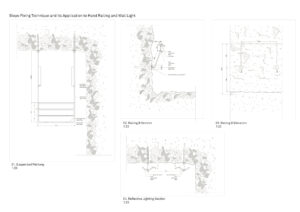Calabronis Water Tower

Calabronis Mining is the oldest mining site in Argentiera, located in the southern terrain, is a mining site connecting to the existing hiking trail. Calabronis Water Tower aims to act as a starter of a self-sustainable system to revitalize silver mining tunnels into new climatic follies to recreate post-mining identity adapting to future tourist development and climate challenges (including global warming, potential drought, flooding issues in mining tunnels in Sardinia) Existing site is not shown from google map, is an isolated open mining site with hidden gate surrounded by steep slope and losses bare rocks.
The excavation volume is first investigated through modular study with minimum light source (i.e. one light source), its connection with topography and spatial combination of staircase, column and viewpoint.

Placement of modules to Calabronis Open Mining is based on two key spatial principles:
1. Max. 30 meter between 2 light sources, to guide movement in-between two nodes
2. Selection of sites with very different sunlight conditions and topography, to recreate extreme sun condition in new caves and avoiding vegetation on ground level to maximize the sunlight in new caves.
Water Tower with largest volume of new cave and new 360 degree viewpoint towards mining heritage is placed on the flat and largest open spaces in the site. The main gate is surrounded by natives endemic floral fields for soil fixation.



1. Micro climate Control: new caves produce and amplify the new micro climate by exploring cave modules and its relationship with one light sources, based on it, a series of experimental excavated gardens are established with various light condition and temperature with its depth underground. Unique cave nursery is created, new potential native plants could be introduced and increase the biodiversity. Reuse of stone from excavation process could be placed to create new cave habitats for pioneer species.
Rooms of unique cave garden are then be formed, for instance, one big Ficus species with complex aerial roots exposed in the cave, providing new shelter for insects.
2. Water Movement flows toward Water Tower and Pumping from Water Tower for preventing flooding inside the tunnel during raining season. Additional mist device could be implemented to improve the recreational and ecological value.
3. Cooling Effect: On top of the stable temperature changes in cave, by controlling water level inside the cave during dry and raining season, humidity and temperature is possible to be invented to create cooling effect, especially under the threat of global warming, it provides new shelter for animal and human.
4. Slope Fixing Technique with rock bolt , which inspires the detail design of staircase, handrailings, and reflective lights for showcasing pattern of mineral stone on the wall.Hand railing with LED lighting is a key way finding design during the night time.
5. The combination of water tank and cave is a sculptural landmark which is not just managing water but symbolize the water scarcity is- sue in Argentiera regardless of its popular recreational water culture. Local should be prioritized over tourist.
6. Cladding Materials:
Reuse Stone from Stone Excavation of Original Site
7. The spatial modules following 2 key spatial principles and the micro-climate created might be able to create thousands of new islands of biodiverse post-mining caves in Sardinia.
8. To conclude, Calabronis water tower is to embrace the old mining history and create a self-sustaining system for water management and biodiverse experimental cave gardens, which is a testing point and potentially applicable to the whole Sardinia with similar situations. It is a tower for both the locals and tourists to achieve sustainable development in the long run, balancing social, economic and ecological values.



Summary
Calabronis Water Tower aims to act as a starter of a self-sustainable system to revitalize silver mining tunnels into new climatic follies to recreate post-mining identity adapting to future tourist development and climate challenges (including global warming, potential drought, flooding issues in mining tunnels in Sardinia)
Calabronis water tower is to embrace the old mining history and create a self-sustaining system for water management and biodiverse subterranean experimental cave gardens, which is a testing point and potentially applicable to the whole Sardinia with similar situations. It is a tower for both the locals and tourists to achieve sustainable development in the long run.
Author: Lai Ching Ng
Credit:
Han Shijia
Gabriel Ochoa Svendberg
Luis Callejas
Gro Bonesmo
Maximilian Schob
Luis Callejas




